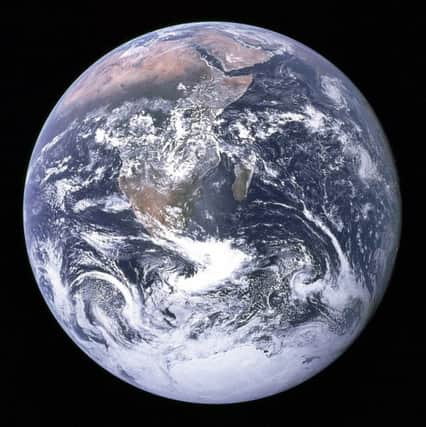Exactly 50 years ago... the starriest Christmas ever


As they completed one and a half orbits of the planet in the spacecraft Apollo 8, Commander Frank Borman and command module pilot Jim Lovell pointed a television camera at earth, and for the first time mankind saw its home from space.
It was a tiny, lovely and fragile “blue marble” hanging in the blackness, said the spacemen as they sent Christmas Eve greetings to humanity and read from the Bible: “God created the heavens and the Earth, and the Earth was without form and void.”
Advertisement
Hide AdAdvertisement
Hide AdIn an age when satellite images of our planet are as familiar as pictures of the seaside, the wonder of that first, fuzzy picture from space, exactly half a century ago, is hard to comprehend.
But with a spacecraft now on Mars and the world preparing to mark the 50th anniversary of the first moon landing next summer, the interest in stellar exploration is at its highest for years.
Jeremy Hopwood is too young to remember the events of 1969 but the exploits of Lovell, Borman and the astronauts who followed inspired him to spend much of his childhood gazing at the stars through a telescope.
“What we’ve learned most was about spaceflight – getting rockets to go up and spacecraft to land, and you see that today in the mission to Mars. It’s an amazing feat,” said Dr Hopwood, now an environmental earth scientist at Huddersfield University, where he continues to take a keen interest in space missions and astronomy.
Advertisement
Hide AdAdvertisement
Hide AdBut he acknowledges that the jury is still out on whether the Apollo missions of the 1960s and 70s were entirely in the cause of the betterment of humanity, or a political show of one-upmanship between the United States and the Soviet Union.
“President Kennedy decided that America had to get someone on the moon by the end of the decade. He put in a huge amount of money, and some people lost their lives in pursuit of his dream,” he said.
The moon landing itself was an event that galvanized the world like nothing before or since.
Uttering possibly the most famous words of the 20th century, at least in peacetime, Neil Armstrong declared the moment to be “one small step for man, one giant leap for mankind.”
Advertisement
Hide AdAdvertisement
Hide AdHis crew left behind a plaque bearing the inscription: Here, men from planet earth first set foot upon the moon, We came in peace for all mankind.
“It sealed America’s position as the dominant technical power, and they went about collecting rocks and bringing them back, but there was a limit to what they could learn,” said Dr Hopwood.
But after their safe return to earth, it became apparent that with Kennedy’s mission accomplished, there was nothing beyond the final frontier. The space agency Nasa found itself competing for funds with other pressing considerations of the time – not least America’s involvement in Vietnam.
Successive moon landings were barely even covered on TV, as interest waned. The last one, by astronauts on board Apollo 17, was in December 1972.
Advertisement
Hide AdAdvertisement
Hide AdYet the period is now seen as a golden age, Dr Hopwood said.
“When Donald Trump goes on about making America great again, what he perhaps means is taking it back to those times. For that reason, Nasa is one of the agencies he is interested in.
“People’s interest did wane, but when you look at what’s happening on Mars, you can see it heightening again. The Voyager mission, outside the solar system, has been absolutely amazing – it’s one of the most successful expeditions Nasa has ever done.”
Boxing Day: How the royals reinvented themselves.